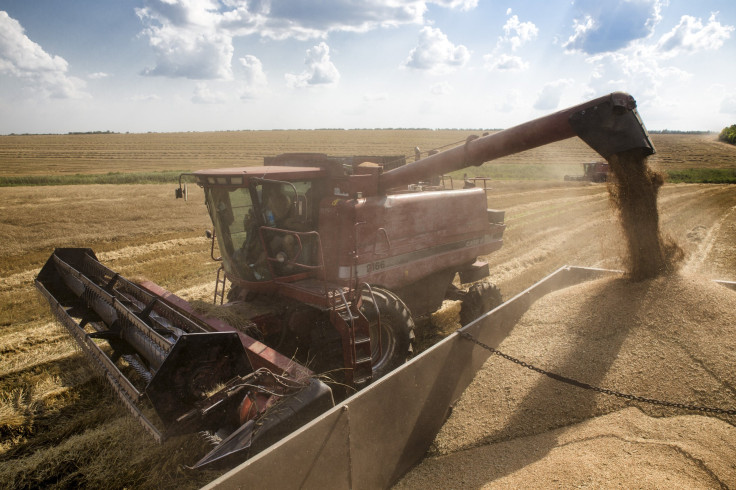Ukrainian & Russian Grain Markets Rare Points Of Stability Amid Ongoing Crisis

As the crisis between Ukraine and Russia drags on with no resolution in sight, both nations’ grain sectors seem to be weathering the storm without major disruptions.
Corn and wheat prices rose in both countries in the beginning of March as observers around the world predicted that uncertainty in Ukraine would disrupt Black Sea shipping and forecast greatly diminished crops of corn and wheat, of which both Ukraine and Russia are leading producers. These projections contributed to a spike in global grain prices.
But prices of the key commodities have leveled off in recent weeks, a development that reflects waning anxiety over Ukraine and Russia’s 2014 agricultural output, and their ability to deliver wheat and corn to consumers.
“Cash prices of Russian and [Ukrainian] wheat [were] up as much as $10 a ton over the last two weeks of March,” Roy Huckabay, executive vice president at the Chicago-based Linn Group, explained via email. “Over the last week the values set back $3 to $4. Corn never rallied that much -- more like $3 to $5 -- and has set back last week to about where it all started.”
As the world’s fourth-largest corn exporter and sixth-largest wheat exporter as of last year, Ukraine is a major driver of international grain markets, as is Russia, which clocks in as the seventh-largest corn exporter and fifth-largest wheat exporter. Because the two nations play such a vital role in supplying the world with food, news that Russia was dispatching military forces to Crimea in late February and early March initially had market watchers and investors wringing their hands.
“The market really anticipated that we [the U.S.] would have increased export potential when the news first broke. The market anticipated that exports would increase from the U.S. to European countries … as a result of the combination of the unrest and sanctions,” Brian Hoops, president and senior market analyst at the Missouri-based Midwest Market Solutions Inc., explained via phone. “It wasn’t anything specific that happened; it was more of a perception that those countries would not be able to ship wheat and that the U.S. would get some of that export business.”
But that sense of trepidation has eased recently, a fact that was reflected in the dropoff of wheat prices over the past two weeks and the relative stabilization of the corn market since the initial jump in early March.
The renewed sense of faith in these key agricultural markets is rooted in a widespread sense that since corn and wheat are currently trading at relatively high prices, there is sufficient incentive for close-to-normal yields to be produced this year in Ukraine and Russia.
“The Black Sea shipping has been uninterrupted, so that’s a plus, and that was the first concern. The second one is we can ship it, now can we grow it? I think the feeling for the most part, with the value of grain at the current price -- pretty lofty but down from where it was -- is that it’s still going to get planted,” Don Roose, president of Iowa-based U.S. Commodities Inc., said via phone.
“Most people are going to try to plant for the profitability that’s there despite the uncertainty. I think things have kind of calmed somewhat … so with the tensions easing that has eased some of the concerns of some of the producers.”
Not all observers are as confident in the ability of the ex-Soviet nations’ grain markets to weather the crisis. Art Durnev, a finance professor at the University of Iowa’s Tippie College of Business who grew up in the Soviet Union and Russia and is considered an expert on the region, believes that the situation remains more fluid.
“It’s hard to say. There’s a lot of uncertainty there right now, and if it continues there is a lot of potential impact on the agricultural markets there,” Durnev said via phone. “The prices will continue to increase until there is some stability in that region. … It’s all pretty much a day-by-day situation there right now.”
Still, most experts have tempered the dire predictions for grain markets voiced by some after the Russian seizure of key buildings in the Crimean capital, Simferopol, on Feb. 27 and 28, and the markets have leveled off as farmers get ready to plant for the 2014 growing season.
“There’s still a little bit of concern, but because there hasn’t been any express news in a couple of weeks, it has kind of moved away from being a major pricing influence,” Hoops said, adding that “we want to see if there’s any new political unrest that comes out of these markets.”
In fact, the all-important weather outlook has replaced the political crisis as the dominant concern for Ukraine’s grain markets, according to Roose.
“I think probably knowing what we know about the Ukrainian-Russian turmoil -- and it still is bubbling a bit -- we’ve kind of matured to a level where we’ve kind of calmed,” he said. “But I think what we’re really watching is what the weather is in some of these areas. It’s been dry in Ukraine.”
© Copyright IBTimes 2025. All rights reserved.





















